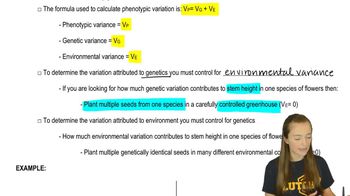Table of contents
- 1. Introduction to Genetics51m
- 2. Mendel's Laws of Inheritance3h 37m
- 3. Extensions to Mendelian Inheritance2h 41m
- 4. Genetic Mapping and Linkage2h 28m
- 5. Genetics of Bacteria and Viruses1h 21m
- 6. Chromosomal Variation1h 48m
- 7. DNA and Chromosome Structure56m
- 8. DNA Replication1h 10m
- 9. Mitosis and Meiosis1h 34m
- 10. Transcription1h 0m
- 11. Translation58m
- 12. Gene Regulation in Prokaryotes1h 19m
- 13. Gene Regulation in Eukaryotes44m
- 14. Genetic Control of Development44m
- 15. Genomes and Genomics1h 50m
- 16. Transposable Elements47m
- 17. Mutation, Repair, and Recombination1h 6m
- 18. Molecular Genetic Tools19m
- 19. Cancer Genetics29m
- 20. Quantitative Genetics1h 26m
- 21. Population Genetics50m
- 22. Evolutionary Genetics29m
20. Quantitative Genetics
Analyzing Trait Variance
Problem 22a
Textbook Question
Suppose a polygenic system for producing color in kernels of a grain is controlled by three additive genes, G, M, and T. There are two alleles of each gene, G₁ and G₂, M₁, and M₂, and T₁ and T₂. The phenotypic effects of the three genotypes of the G gene are G₁G₁ = 6 units of color, G₁G₂ = 3 units of color, and G₂G₂ = 1 unit of color. The phenotypic effects for genes M and T are similar, giving the phenotype of a plant with the genotype G₁G₁M₁M₁T₁T₁ a total of 18 units of color and a plant with the genotype G₂G₂M₂M₂T₂T₂ a total of 3 units of color. Suppose that instead of an additive genetic system, kernel-color determination in this organism is a threshold system. The appearance of color in kernels requires nine or more units of color; otherwise, kernels have no color and appear white. In other words, plants whose phenotypes contain eight or fewer units of color are white. Based on the threshold model, what proportion of the F₂ progeny produced by the trihybrid cross in part (b) will be white? Explain your answer.
 Verified step by step guidance
Verified step by step guidance1
Identify the genotypes for each gene (G, M, T) and their corresponding phenotypic color units: G₁G₁ = 6, G₁G₂ = 3, G₂G₂ = 1; similarly for M and T.
Calculate the total color units for each possible genotype combination in the F₂ generation by adding the units from G, M, and T.
Determine which genotype combinations result in a total of 8 or fewer color units, as these will be white according to the threshold model.
Calculate the probability of each genotype combination occurring in the F₂ generation using Mendelian inheritance ratios (e.g., 1:2:1 for each gene).
Sum the probabilities of all genotype combinations that result in 8 or fewer color units to find the proportion of white kernels in the F₂ progeny.
Recommended similar problem, with video answer:
 Verified Solution
Verified SolutionThis video solution was recommended by our tutors as helpful for the problem above
Video duration:
3mPlay a video:
Was this helpful?
Key Concepts
Here are the essential concepts you must grasp in order to answer the question correctly.
Polygenic Inheritance
Polygenic inheritance refers to the phenomenon where multiple genes contribute to a single trait, resulting in a continuous range of phenotypes. In this case, three additive genes (G, M, and T) influence kernel color, with each gene having two alleles that contribute varying amounts to the overall phenotype. Understanding this concept is crucial for analyzing how different combinations of alleles can lead to diverse color outcomes in the progeny.
Recommended video:
Guided course

Organelle Inheritance
Additive Effects of Alleles
Additive effects occur when the contributions of different alleles combine to produce a cumulative effect on the phenotype. For example, in the given scenario, the G gene has specific phenotypic values associated with its genotypes, which add up with the contributions from the M and T genes. This concept is essential for calculating the total units of color produced by various genotypes and determining which combinations meet the threshold for color expression.
Recommended video:
Guided course

Maternal Effect
Threshold Trait
A threshold trait is a type of trait where a certain level of genetic contribution must be reached before a specific phenotype is expressed. In this case, a kernel must accumulate at least nine units of color to appear colored; otherwise, it appears white. Understanding this concept helps in predicting the proportion of progeny that will exhibit the white phenotype based on the genetic combinations derived from the trihybrid cross.
Recommended video:
Guided course

Traits and Variance

 8:34m
8:34mWatch next
Master Analyzing Trait Variance with a bite sized video explanation from Kylia Goodner
Start learningRelated Videos
Related Practice


